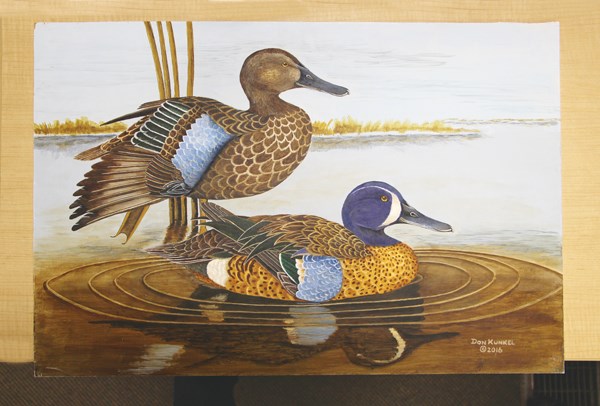Don Kunkel is hoping a trio of canvasback ducks will find their way to a conversation stamp.
The Yorkton artist has been entering his works for a number of years in an annual Wildlife Habitat Canada competition where the final selected work goes on the annual stamp.
“Artists from across Canada enter,” explained Kunkel. “It started out years ago when Robert Bateman did the first one … He’s just a wonderful guy. He’s absolutely the best wildlife artist working in the world.
“And he’s salt of the earth.”
Kunkel noted he met Bateman years ago when he was not doing much with his art, and he took the time to review his portfolio and encourage him to get back to painting.
The competition always highlights a migratory game bird.
Kunkel said the competition is one which gives many artists an opportunity. The competition attracts 50-to-75 entries each year.
“There are up and coming artists, and old codgers like me,” he said.
When someone has their work selected to grace a stamp one year, they have to sit out the competition two years.
Kunkel has been entering for a number of years, and while he has come close, he has yet to have a work selected for a stamp.
“I’ve had a top-five a couple of times,” he said, adding he is hopeful about his canvasbacks. “This one has some potential, but we will see.”
Kunkel said each year there is a specific bird that must be painted, and since it is a Canada-wide event it is often a species not commonly known in Saskatchewan. That can be a challenge in itself.
For example, he did a mourning dove one year he thought was good.
“I’ve had them in my back yard,” said Kunkel, adding they are not seen as a game bird here, but in places such as Texas it is commonly hunted.
“I really thought my mourning doves were good, but Allan Hancock’s were better and I’ll give him credit for it too,” he said.
Regardless of the species, the first criteria for the judges is that the bird reflects a real one.
“The first element is anatomical inconsistencies,” he said, adding they actually have bird biologists review the works as the initial phase of judging.
That can be a challenge when the subject is a surf scoter, as was the case a few years ago.
Kunkel admitted he knew almost nothing about the bird, so his first step was research.
“Fortunately the web’s fantastic,” he said.
The surf scoter is a large sea duck native to North America. Adult males are entirely black with characteristic white patches on the forehead and the nape and adult females are slightly smaller and browner. Surf scoters breed in Northern Canada and Alaska and winters along the Pacific and Atlantic coasts of North America. They are a diving duck.
After the bird itself looks right, it’s a case of putting it in a place it belongs.
“You paint them in their natural habitat,” said Kunkel.
In general terms it helps that Kunkel says he is something of a birder, watching them on an amateur level. Birding allows him to take many photographs which are an asset in his art.
It’s rarely a case of placing the birds in an exact representation of a particular tree or slough, but experience helps Kunkel make the background look natural.
In the canvasback work Kunkel opted to show three birds, two drakes and a hen, not just a pair.
“That’s the way you often see them in nature,” he said, adding the drakes are seeking an opportunity to actually knock the hen out of the air to mate with.
The three birds in flight is a bit different too, since most winners show birds stationary on the ground. Kunkel said going with birds in flight is hopefully a way to catch the eyes of the judges.
A work, such as the canvasbacks would take Kunkel a month if he dedicated to it daily, but “I play golf,” he noted, so they progress more slowly.
The canvasback ducks art piece has been sent to Ontario unsigned where judges will make their decisions without knowing who the art was. Kunkel said he should here how his work did around mid-November.
If this is his year to top the field the work would be on a habitat stamp in 2018.
In the meantime, Kunkel said he plans to be more active at his easel, setting a goal of a work a month, including one of the signature number eight hole at Deer Park Municipal Golf Course.
“Every golf course has a signature hole, so I hope to do a few of those,” he said.



